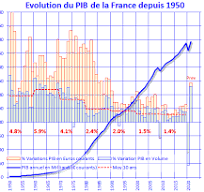On January 1, 1999, eleven countries would replace their respective currencies with one. The Euro became the single currency of 300 million Europeans, an unprecedented undertaking. Another unparalleled precedent: the very model of the Euro, a currency without a sovereign state. The common monetary policy is entrusted to a federal institution, but economic and fiscal policies are left to the discretion of the states. To meet this challenge of collective management, a common discipline was put in place with fiscal rules, a deficit of less than 3% of GDP and a public debt of less than 60% of GDP, to which all states committed to, in the Stability and Growth Pact. Nine countries have joined the eleven founding members, and the Euro, the second most important currency in the global monetary system, has played a role in protecting and developing the European economy both internally and externally, and has withstood four major crises (2008, sovereign debt 2010-2012, Covid and inflation from 2021). But it did not bring all the expected benefits because some member states refused the required economic discipline. Worse, some states took advantage of the protection of the Euro to let deteriorating their public finances, thus weakening their productive apparatus, destroying their credibility and fueling the mistrust of their partners. These economic disparities emerged as soon as the Euro was created, with the countries of the North focusing on strengthening their industrial base and controlling public finances, while the countries of the South favored credit, consumption, and social redistribution without worrying about the budgetary consequences and inflation. These two “models” coexisted until reality took revenge and led to the sovereign debt crisis. As a result of this crisis, the countries of the South, with the notable exception of France, improved their fundamentals, greatly helped by the exceptionally accommodating and long policy of the ECB. While inflation reached levels never seen since the creation of the monetary union, the ECB continued this policy, creating adverse effects on productive investment, now zombie companies, dependent on productivity, creating speculative bubbles and promoting State indebtedness. The monetary Union is at a decisive turning point. But what to do? The author first tells us what not to do. Structural problems cannot be solved by an increase in debt. We must stop easing the money creation, the monetization of debt is not the solution, there is no European magic money. Budgetary discipline is essential, we must lower current spending, and revive productive investment. Reviving the European economy will require improving financing conditions, creating pension funds to drain savings into corporate equity to encourage innovation, revive securitization, and achieve a true banking Union. And finally, we must stop considering the violation of common budgetary rules by a number of states as an acceptable and credible solution. Dider Cahen, PhD in Economics, is the General Delegate of Eurofi, a think tank that promotes the single market for banking and financial services in Europe. Ph Alezard
Marie-Laure BARUT-ETHERINGTON et Pierre BOLLON (dir), Où va l’épargne ? Revue d’Economie Financière , n°158, 2e trim 2025
In these times of investment needs, in order to respond to energy, environmental, economic, and budgetary transitions, public opinion is tempted to seek answers (culprits?) among the so-called “wealthy” members of society and “big business.” Nothing new in itself, except for the inclusion of savings in this never-ending quest for new scapegoats. The age-old debate that divides economists is back in the news, with the question of whether savings (described in France as excessive) – but immutable as a republican virtue – could become a brake on investment, growth, employment and, ultimately, demand itself. This new publication from the REF, which draws on a host of prestigious economists, is timely. In three richly documented chapters, the authors contribute factual elements, context, and a long-term strategic vision to the debate. The first chapter provides an overview of savings trends in France compared with Europe, while the second chapter examines the heterogeneity of savings behavior in several dimensions (in relation to the holding of risky assets, household characteristics, product life cycles, and the role of public policy). Finally, the third part sheds light on the important issue of mobilizing private savings to benefit the French and European economies. It should be noted that in France, although individuals save a lot (15% of their income on average, which is higher than in most OECD countries), they do so rather poorly, favoring liquid and less risky assets. Low stock ownership and the increase in foreign stock holdings have negative consequences in terms of sovereignty and competitiveness for our country. The need for regulations that place less emphasis on “safe and liquid” assets is being called for by all financial players and insurers, banks, and asset managers. The authors argue for accelerating the implementation of a genuine “Savings and Investment Union,” identifying four priority areas: redesigning market infrastructure to reduce costs, unifying capital market supervision for better risk sharing, reviving securitization, financing the green transition, and promoting the European venture capital industry that finances innovative companies. As this remarkable publication shows, the new path that seems to be opening up for savings is full of great promises… no doubt still accompanied for a long time to come by the popular saying: “If you don’t save a penny, you’ll never have two.” Marie-Laure BARUT-ETHERINGTON is a Deputy GM at the Banque de France. Pierre BOLLON is Director of European Affairs at the EIF. Jean-louis CHAMBON
Edouard DOLLEY, Vers une finance durable, Eds Franel, 2025, 312 pages.
The book is interesting in more ways than one: educational, practical, inspiring. You can’t do sustainable finance without doing finance first! This book introduces the main concepts of corporate and market finance, then explains how these concepts are relevant to sustainable finance. Each chapter focuses on a financial concept: wealth, interest rates, returns, balance sheets, asset portfolios, arbitrage, derivatives, and even crypto-assets! This book thus provides a bridge between “traditional” finance and sustainable finance. That covers the educational aspect. It is practical thanks to its original format. In each chapter, the concepts are explained by teachers and practitioners: CFOs, central bankers, commercial bankers, investment bankers, managers, trading room managers, appraisers, accountants, auditors, business leaders, and more. We learn that concepts such as IRR, required rate of return, risk-free rate, company buyouts, arbitrage, CAPM, options and derivatives, and extra-financial valuation are applicable to the models and functioning of sustainable finance. The book is inspiring because it is not a pro domo plea for sustainable finance. On the contrary, the choice of interviewees leads us to question the current systemic limitations: difficulties in determining the rate of return on an ESG project and calculating environmental value, the intrinsic value of carbon, questions about regulations and SRI evaluators, etc. Each chapter includes a conclusion in a few points that summarizes the previous discussion and raises questions, an inspiring format! Natural and social capital cannot be reduced to numbers, but numbers are essential and it is crucial to collect reliable data. And “classic” financial concepts provide a solid foundation that can be adapted to the analysis of broader issues, particularly sustainability. The author rightly asserts that the green and sustainable transition will require a return of trust, governance, and value, and the current difficulties are not overlooked. Regarding trust, E. DOLLEY affirms the need to develop blockchains. Given their energy consumption, this point seems counterintuitive, but the arguments put forward are strong. The traceability of funds invested in projects, the reliability of upstream data that is so difficult to obtain that the OMNIBUS Directive has limited the obligations to obtain it, and “certified” renewable energy sources would justify and satisfy the information needs of economic agents. This book does not develop ready-made solutions, but it provides a kind of serious and accessible compendium. Thus, the transition would be driven by a “bottom-up” approach, as the top-down approach has, according to the author, reached its well-defined limits. Dominique Chesneau
Antoine FOUCHER, Sortir du travail qui ne paie plus, Eds L’Aube, 2025, 138 pages.
The reader will not find in this booklet “the means to earn more by working less”, but he will know how to rebuild a society based on work, allowing both to live better and to acquire a patrimony. The author notes that labor productivity has declined since the 1980s, due to the country’s deindustrialization and the weakening of skills due to educational downgrading. He recalls that France was downgraded from the 6th to the 27th place in the world ranking of GDP per capita. He notes that the purchasing power of the French is no longer progressing and that two-thirds of their wealth comes from inheritances. The French who do not work live better than those who do. Work only supports purchasing power through social assistance in all forms. The progressivity of taxes and contributions financing these aids also discourages employees from working overtime and employers from recruiting and/or increasing the wages of their employees. Workers retain, on average, only half of their gross earnings, while rentiers receive one third, pensioners one sixth, and heirs less than one tenth. This results in different forms of resistance to work, which mobilize more protesters than other social conflicts, encourage sick leave, “silent resignations” and/or rejections of “bullshit jobs”. In 2025, the working population must also support twice as many retirees as in 1980. According to the author, this phenomenon is due to an unequal distribution of the value created by labor, which favors both financial and real estate capital. The French no longer believe in the “collective discourse” that orders them to get back to work. The author therefore strives to propose a new “social contract” aimed at bridging the gap between the living standards of workers, rentiers, retirees, and heirs. He proposes measures to enhance the value of work and the purchasing power of assets through better remuneration, thanks to more professional training, a revival of innovation (especially through AI), a reindustrialization of the country associated with a limitation of imports of dumped products, a more flexible employment and greater professional mobility. He advocates a “revenge of employees on customers”, by redistributing VAT rates in favor of basic necessities. He advises building a “new ideal of work”, based on the values of responsibility, respect, and empathy. The author engages in a rigorous and educational exercise of analyzing the French evil of professional attrition and formulates coherent proposals to deal with it. Antoine Foucher was director of the cabinet of a minister of labor. He currently heads the consulting firm Quintet.Jean-Jacques Pluchart
Françoise BENHAMOU (dir.) , L’économie sans intox. Retraites, pouvoir d’achat, dette…16 économistes rétablissent les faits, Eds Eyrolles, 2025, 180 pages.
The Cercle des Economistes signs its latest work under a title borrowed from the populist press, its attempts to answer the main economic and social questions that the French are asking to each other’s in these troubled times. The book brings together the best specialists in the fields covered: the fragmentation of the world economy; the questions of debt and the French employment rate; labor immigration; public money financing culture. In each chapter, the authors emphasize the importance of the questions asked, analyze – or rather criticize – the answers generally given to these questions by political circles and the media, and then, drawing on the best sources, engage in useful “reasoned returns to facts” and “deconstructions of myths”, to finally formulate concrete proposals to revamp the fundamentals of the country. The reader of the book will note that in economic and social matters, elected officials and the media too often engage in abusive simplifications, the propagation of counter-truths and clever simulations, in order to defend ideologies and justify programs with improbable effects. The reader will find that the unemployment rates of “the young and the old” are abnormally higher than those of other Western countries, and that more than 600,000 French seniors are virtually without resources. The reader will also learn that the actual working hours of French workers of working age is close to the European average, that the expulsion of “working immigrants” would ruin the construction, catering, and domestic services sectors. They will be surprised to learn that the responsibility for France’s public over-indebtedness is more attributable to right-wing policies (favorable to tax cuts) than to the left (oriented towards corporate taxation). They will learn that economic growth can be combined with a search for happiness without indulging in laziness, and that the promotion of culture involves both public and private fundings. After reading the book, the reader will remain skeptical about the chances of sorting out the country’s fundamentals in the short or medium terms. The 16 authors are teacher-researchers and leaders of institutions, members of the Cercle des Economistes.J-J. Pluchart
Nicolas TENZER, Fin de la politique des grandes puissances, Eds L’Observatoire, 327 pages, avril 2025
What if power no longer belonged to the great nations? Nicolas Tenzer is certain: the days of the traditional great powers are numbered. Trump’s United States has broken the Atlantic Alliance; China, which remains a predatory power, is bogged down in its internal contradictions; Russia is facing a “no future” scenario. There is now a persistent belief in many diplomatic circles that international politics is essentially determined by the major powers and their games. Other countries are certainly not unimportant in this conventional view, and their policies may sometimes be disruptive, but they never have the final say! However, the return to “American greatness,” which must be based on a rapprochement with China, heralds America’s decline. The major countries that are members of the Security Council have cherished the idea of a closed club of five all the more because it projected an image as flattering as precarious makeup! However, playing on permanent ambiguity gives the illusion of power in the absence of confidence, but hides a lack of will. At the same time, some describe Russia as a paper tiger, and it is not clear that the prediction of China becoming the world’s leading economic, technological, and military power by 2049 will come true! The possible or even emerging multipolarity of the world would lead to the emergence of revisionist states. The radical fragmentation of the poles could also bring about freedom. More agile players ARE likely to reinvent the rules of the international game: Estonia, a pioneer in warning about Europe’s security, Turkey if it manages to choose sides, Syria freed from its criminal occupations, but also the medium-sized powers of Central and Eastern Asia. Together, the democracies of the North, South, and East will join forces against the revisionist powers. Together, they will be able to stand up to the pseudo-empires. France and the United Kingdom will have to play a leading role in this realignment. As for Ukraine, its heroic resistance demonstrates the ability of medium-sized states to stand up to the old powers. Through an analysis of the new balance of power, Nicolas Tenzer reveals how these “intermediate” states are redrawing the map of the world: they are creating unprecedented alliances, developing original strategies of influence, and proving that it is possible to exert greater influence on the international stage without being a superpower. Tomorrow, world security and the freedom of peoples will depend on the determination of small and medium-sized nations. The Trump episode may have been the moment when this realization dawned. The author reviews the power limitations of post-colonial states, China, the United States, India, African disorganization, and the lack of strategy in Middle Eastern countries. At the same time, resistance among peoples is emerging, along with a so-called “Ukrainian” model for the nation of the future. So: G-Zero or G-Infinity? How can stability be built? The signal sent by a Ukrainian victory will undoubtedly be decisive, both symbolically and in practice, and could inspire others to follow suit. This victory is therefore existential for Europe and other medium-sized powers! The strength of an armed people is underestimated until its next victories. While in the old world it was customary to consider that the great powers formed an axis of security, “tomorrow’s security and freedom will come through small and medium-sized states.” The book is supported by highly relevant observations thanks to the author’s geopolitical erudition. Like any projection, the book’s conclusions will not necessarily prove true, but they may. This book is necessary to help us escape the media chaos and take a step back. Readers will gain information and reasoning that will allow them to refine their own views. Whether you agree with the thesis or not, it must be known. In the dark environment of a world at war, this book is a tunnel at the end of which there is a legitimate element of optimism. Dominique CHESNEAU
Celine et Nadia ANTONIN, Crypto actifs, Editions Economica, 2025
Crypto Assets and Non-Crypto Currencies. From the outset, the two authors, experts on the technical, economic, and geopolitical aspects of payment methods, warn us against fundamental errors in the assessment of so-called “crypto currencies”, such as the bitcoin. They do not fulfill the attributes of a currency, which are to be a unit of account, a means of intermediation of exchanges, and finally a reserve of value; the authors prefer to speak of crypto-assets which, in the absence of effective regulatory bodies, present considerable risks, essentially linked to an uncontrolled volatility without concrete counterparts and do not constitute, in any way, a reserve of value. A large part of the book is devoted to the risks generated by the uncontrolled expansion of crypto assets. For example, the anonymity of asset ownership and the impossibility of tracing the underlying transactions, the extreme volatility of the prices of these assets, the meteoric expansion of illicit transactions related to money laundering or arms trafficking on the dark web. Overall, in the absence of a framework by central banks, the flow of crypto-assets poses a threat to the monetary and financial order. The book then develops the opportunities offered by the underlying technologies around the blockchain. This technology, properly used, that is to say, exploited in an appropriate regulatory framework, can serve as a platform for the decentralization of part of the financial activities, for example for certain specialized and duly regulated credits and secured payment operations. The major issue is the sovereignty of Central Banks, which may be dispossessed of their role in regulating official currencies. In this respect, the book is a driving force for a controlled use of crypto assets which must not, under any circumstances, become an official currency. Denis Molho
Serge Eric MENYE, L’Afrique sera-t-elle la catastrophe du XXIe siècle ?, Bibliomonde, avril 2025, 150 pages
In an incisive essay with a deliberately provocative title, Serge Eric Menye questions the destiny of the African continent: Will Africa be the catastrophe of the 21st century? The book, short in volume but dense in its purpose, seeks to break a narrative that has dominated media and institutional discourse for more than fifteen years. We remember, in fact, the enthusiasm aroused in the early 2010s by a study by the consulting firm McKinsey, by the forecasts of the African Development Bank, and by an often fiercely optimistic economic press: this continent was then presented as the “next Eldorado”, the future Asian relay of global growth. However, Menye intends to demonstrate that this perspective is illusory. His diagnosis is clear: far from being the radiant future that was announced, Africa has become bogged down in a vicious cycle of poverty, poor governance, and conflict. Far from benefiting from decades of global growth and the massive decline in poverty observed elsewhere, the African continent has experienced a worsening of its difficulties. The author, however, does not limit himself to making this grim observation. By adopting a three-part structure, identifying the causes of endemic poverty, designating responsibilities, highlighting strengths and prospects, he proposes a dialectical reading: after the presentation of defects and failures, come the immense resources and positive examples that allow us to believe that another path remains possible. The first part of the book meticulously describes the obstacles that explain the rooting of poverty. Africa, explains Menye, has missed all the “trains” of global growth over the last fifty years: the globalization of trade, the digital revolution, the digitization of economies. While Asia has been able to take advantage of these dynamics to become a major player, Africa has remained on the sidelines. Its economies remain largely archaic, focused on the export of raw materials, unable to generate added value and create massive jobs. The case of Nigeria is revealing: the continent’s leading oil producer, it still imports 90% of its gasoline needs, due to a lack of refining infrastructure.This economic structure explains the persistent weakness of growth, too modest to absorb the demographic pressure. The African population, estimated at 1.5 billion today, is expected to reach 4.5 billion in 2100. This demographic shock dilutes all efforts: every investment in education, every progress in health, is neutralized by the constant increase in the number of potential beneficiaries.The figures put forward by the author are striking. In 1960, 10% of the world’s poor lived in Africa. In 2000, the proportion reached 60%. And according to projections, by 2030, 90% of people living in extreme poverty will be African. This historic reversal illustrates the continent’s failure to benefit from the global dynamics that have, on the whole, massively reduced poverty elsewhere.Added to this is a dramatic illiteracy, which still affects more than half of the population. Without education, no economic modernization is possible. The lack of infrastructure, roads, electricity, hospitals, schools, slows down any industrialization. The crushing debt is another burden. The sums spent on repayment deprive states of the means necessary to finance education, health, or critical infrastructure. Chronic indebtedness thus locks many African countries into a vicious circle: without investment, growth remains weak, and without growth, debt cannot be absorbed. To these structural handicaps is added the scourge of armed conflicts. For territories, resources, or identity rivalries, wars erupt with disconcerting regularity. These clashes leave economies bled dry, destroy scarce infrastructure, cause massive population displacements, and exacerbate food crises. The author cites a frightening figure: since 1990, these conflicts have cost the continent about 300 billion dollars. However, no one can build economic activity without the indispensable confidence provided by security and civil peace. Endemic corruption completes this picture. It affects all spheres of society and costs about 25% of the wealth produced each year. In such contexts, foreign investment is scarce, entrepreneurship is withering and the informal economy is proliferating. This informal sector, which is the majority, is a real poverty trap: low wages, lack of social protection, non-existent taxation, illegal or dangerous activities for health. It is on this soil that mafias, arms and drug trafficking, counterfeit medicines (responsible for nearly half a million deaths each year according to the UN), and the financing of terrorism thrive.The political situation is hardly more reassuring. In many countries, regimes are authoritarian, institutions are weak, and elites are predatory. Power, often monopolized by dynasties, is not based on merit or competence. Corruption, cronyism, and massive embezzlement of public money widen the gap between leaders and populations. Some exceptions exist, however: Botswana, Ghana, Senegal, Namibia, Somaliland, and Rwanda have each, in their own way, succeeded in establishing a more stable and democratic governance. But these examples remain in the minority and their effects, although real, are still limited on the continent. II. Responsibilities for the African disaster In the second part, Serge Eric Menye lists those responsible for this situation. He goes beyond the simplistic explanations that attribute all of Africa’s difficulties to colonization or slavery. Certainly, these phenomena have deeply marked the continent, but they are not enough to explain the current inability to develop. The real difference, he insists, lies in governance.The generation gap is huge between a young population, the youngest in the world with a median age of less than twenty years, and older leaders, often in power for decades. The latter conceive of power as a “jackpot”, an opportunity for unlimited personal enrichment. The misappropriations and personal fortunes of the leaders, invested in luxury goods abroad, illustrate this drift. Between 2000 and 2015, no less than 836 billion dollars left Africa illegally, more than the total stock of external debt in 2018 (770 billion). But the African elites are not the only ones responsible. External powers, including France, the United States, Russia, Turkey and China, as well as international institutions, play a role deemed “toxic”. Their interventions are not neutral. They sometimes fuel conflicts, sometimes support corrupt regimes, and exploit resources. Moreover, international aid, often praised,
Felix TORRES, Du berceau au tombeau. Une histoire critique de l’Etat-Providence, Eds de l’Eclaireur, 2025, 192 pages.
The author engages in a critical analysis of the French social protection system, based on the welfare state model inherited from Beveridge’s “3 U”. He draws up a genealogy of the notions – both familiar and unknown – of social protection, social security, social state, welfare state, national solidarity, universal minimum income, “inactivity trap” … He analyzes the drifts of the system’s financing and taxation methods, which he compares to the mechanisms implemented in other major democracies. He recalls the successive alarms launched, since the 1970s, by politicians, such as Georges Pompidou and Jacques Chaban Delmas, by historians, such as Pierre Rosanvallon, or by jurists, such as Pierre Laroque. He observes the many attempts – sometimes utopian and often in vain – to “redefine solidarity”, “rethink rights”, “restore duties”, “improve redistribution”, “recover the untraceable budget balance” … He shows the complexity of legal constructions, fiscal adjustments, financial arrangements … to “fill the hole of the Secu”. He reveals that these excesses are both accelerated and inevitable, due to the political instability of the country and the “French taboo of capitalization”. He ironizes the typically French sense of the ideological controversy around the notions of social charges and contributions, insurance and levies, pensions and retirement… He welcomes the zeal of the technocrats who ensure the governance of the State-funded parity, in the absence of structural reforms.The author recommends, following Erell Thevenon, to adopt a model of “State-Providence” located between the “universal and the individual”. The State refocuses on its “core mission” on a “solidarity base”. Private actors are guaranteed by contract against health and occupational risks, depending on their personal life choices. In any case, it seems that the rebalancing of the French system requires “more work” and “less aid”, as well as a reduction of “real inequalities” but also “undue advantages”.Felix Torres (ENS, associate Professor of history, doctor of anthropology) is the author of numerous books on institutions and companies, where he demonstrates a vast economic and social culture and a rare mastery of historical and anthropological approaches. Jean-Jacques Pluchart
The GDP in question
On September 12, Fitch downgraded France’s sovereign debt from AA- (high quality) to A+ (upper average quality). In its analysis, the agency uses GDP as a central indicator to assess the sustainability of public finances, in particular through the debt/GDP ratio. Fitch points out that French public debt is expected to rise from 113.2% of GDP in 2024 to 121% in 2027, with no clear prospect of stabilization. Fitch considers it unlikely that France will bring its public deficit below 3% of GDP by 2029, while the government was aiming for this objective to comply with European rules. The deficit is expected to be 5.4% of GDP in 2025, and should remain above 5% in 2026 and 2027. In this context, the agency believes that France has less room for maneuver in the face of possible economic shocks. According to the latest INSEE estimates, the country’s GDP will grow by 0.8% in 2025 instead of the 0.6% initially forecast, due to better dynamics in agriculture, tourism, the real estate market, and aeronautics. This increase, although positive, is far from expected to offset the weight of the debt. In its latest economic bulletin published on September 25, the ECB presents an overview of the macroeconomic projections of inflation and GDP in the Eurozone, in order to justify its monetary policy. Inflation is expected to be 2.1% in 2025, 1.7% in 2026, and 1.9% in 2027. Growth, meanwhile, is expected to be 1.2% in 2025, 1% in 2026, and 1.3% in 2027. In its statement, “the Governing Council considers it essential to strengthen, without delay, the eurozone and its economy in the current geopolitical environment. Fiscal and structural policies should improve the productivity, competitiveness and resilience of the economy… It is up to governments to prioritize structural reforms and strategic investments that promote growth while ensuring the sustainability of public finances.”The roadmap is therefore clear: GDP must be supported However, is the calculation of GDP still relevant and up-to-date to measure the wealth created by a country? Should its formula evolve as suggested by some economists and politicians? And especially in terms of climate change? GDP is already 80 years old It was at the Bretton Woods conference in 1944 that GDP was adopted as a standard indicator to measure the economic activity of countries, in particular to facilitate international comparisons and post-war reconstruction. It will thus be gradually adopted by the whole world and international organizations, such as the UN, the IMF or the World Bank. In France, it was applied from 1949. Over the years, GDP gradually replaced GNP (Gross National Product) as the main indicator, because it measures production in a territory, regardless of the nationality of the economic actors. In the 70s and 80s, GDP began to include previously neglected sectors such as services. Indeed, developed countries are moving from an industrial economy to a service economy, which changes the structure of GDP The limits of GDP In 2009, the Stiglitz-Sen-Fitoussi report or the “Report on the measurement of economic performance and social progress” was commissioned by Nicolas Sarkozy. Questioning the limits of the calculation of the indicator, this report proposes to supplement the GDP with indicators of well-being, sustainability and inequalities. Indeed, the report points out that GDP: – ignores well-being: it does not measure happiness, health, education, or the quality of the environment;– neglects inequalities: an increase in GDP can hide an increase in income gaps. It ignores sustainability: It does not take into account the degradation of natural capital (resources, climate);– does not value unpaid work, such as volunteering or domestic work.Recently, the ECB also warned its member states that climate change could cut European GDP by 5% by 2030. In France, INSEE proposed in 2024 a complementary indicator to GDP, the “adjusted net domestic product” (Pina): this indicator makes it possible to take climate change into account by netting the creation of value from the effects of future damage and decarbonization costs. Although developments are being studied and considered, GDP is still the reference for a large number of institutions as a management tool; but other dimensions of analysis will have to be added in order to have a more global vision in a context of global warming. Sophie Friot Member of the Turgot Club











